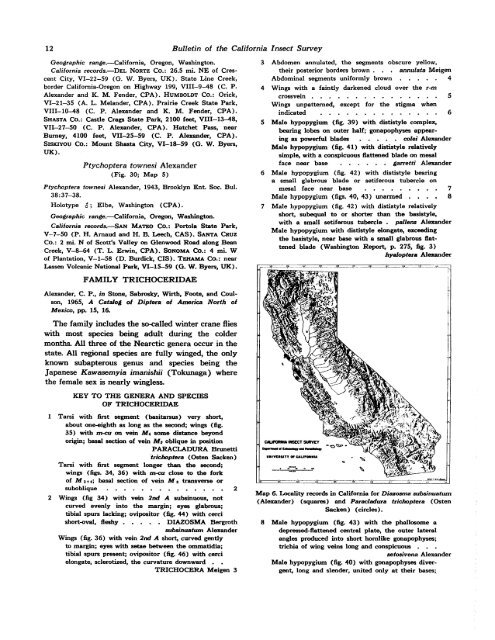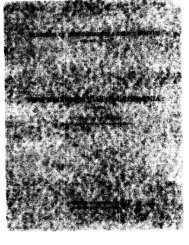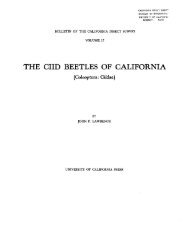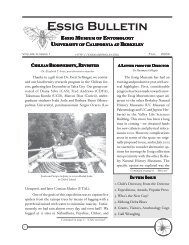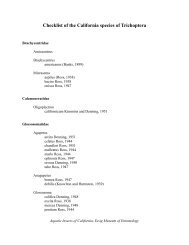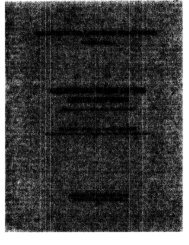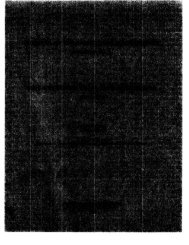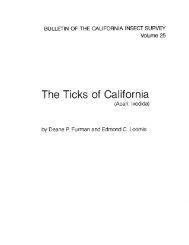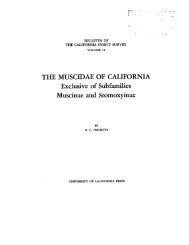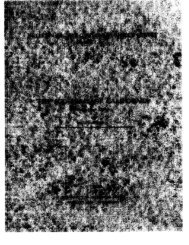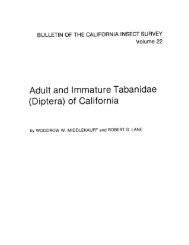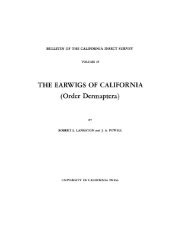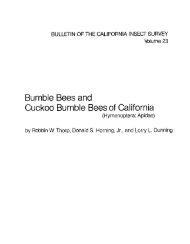The Crane Flies of California - Essig Museum of Entomology ...
The Crane Flies of California - Essig Museum of Entomology ...
The Crane Flies of California - Essig Museum of Entomology ...
Create successful ePaper yourself
Turn your PDF publications into a flip-book with our unique Google optimized e-Paper software.
12 Bulletin <strong>of</strong> the <strong>California</strong> Insect Survey<br />
Geographic range.--<strong>California</strong>, Oregon, Washington.<br />
<strong>California</strong> records.-DEL NORTE CO.: 26.5 mi. NE <strong>of</strong> Crescent<br />
City, VI-22-59 (G. W. Byers, UK). State Line Creek,<br />
border <strong>California</strong>-Oregon on Highway 199, VIII-9-48 (C. P.<br />
Alexander and K. M. Fender, CPA). HUMBOLDT CO.: Orick,<br />
VI-21-35 (A. L. Melander, CPA). Prairie Creek State Park,<br />
VIII-10-48 (C. P. Alexander and K. M. Fender, CPA).<br />
SHASTA CO.: Castle Crags State Park, 2100 feet, VIII-13-48,<br />
VII-27-50 (C. P. Alexander, CPA). Hatchet Pass, near<br />
Burney, 4100 feet, VII-25-59 (C. P. Alexander, CPA).<br />
SISKIYOU CO.: Mount Shasta City, VI-18-59 (G. W. Byers,<br />
UK).<br />
Ptychoptera townesi Alexander<br />
(Fig. 30; Map 5)<br />
Ptychoptera townesi Alexander, 1943, Brooklyn Ent. SOC. Bul.<br />
38~37-38.<br />
Holotype 8; Elbe, Washington (CPA).<br />
Geographic range.-<strong>California</strong>, Oregon, Washington.<br />
<strong>California</strong> -~s.-SAN MATBO CO.: Portola State Park,<br />
V-7-50 (P. H. Arnaud and H. B. k h , CAS). SANTA CRUZ<br />
CO.: 2 mi. N <strong>of</strong> Scott's Valley on Glenwood Road along Bean<br />
Creek, V-8-64 (T. L. Erwin, CPA). SONOMA Co.: 4 mi. W<br />
<strong>of</strong> Plantation, V-1-58 (D. Burdick, CIS). TEHAhlIA (3.: near<br />
Lassen Volcanic National Park, VI-15-59 (G. W. Byers, UK).<br />
FAMILY TRICHOCERIDAE<br />
Alexander, C. P., in Stone, Sabrosky, Wirth, Foote, and Coulson,<br />
1965, A Catalog <strong>of</strong> Diptera <strong>of</strong> America North <strong>of</strong><br />
Mexico, pp. 15, 16.<br />
<strong>The</strong> family includes the so-called winter crane flies<br />
with most species being adult during the colder<br />
months. All three <strong>of</strong> the Nearctic genera occur in the<br />
state. All regional species are fully winged, the only<br />
known subapterous genus and species being the<br />
Japanese Kawasemyia imanishii (Tokunaga) where<br />
the female sex is nearly wingless.<br />
3 Abdomen annulated, the segments obscure yellow,<br />
their posterior borders brown ... annulata Meigen<br />
Abdominal segments uniformly brown ..... 4<br />
4 Wings with a faintly darkened cloud over the r-rn<br />
crossvein ............... 5<br />
Wings unpatterned, except for the stigma when<br />
indicated .............. 6<br />
Male hypopygium (fig. 39) with dististyle complex,<br />
5<br />
bearing lobes on outer half; gonapophyses appearing<br />
as powerful blades ..... colei Alexander<br />
Male hypopygium (fig. 41) with dististyle relatively<br />
simple, with a conspicuous flattened blade on mesal<br />
face near base ...... garretti Alexander<br />
6 Male hypopygium (fig. 42) with dististyle bearing<br />
a small glabrous blade or setiferous tubercle on<br />
mesal face near base ......... 7<br />
Male hypopygium (figs. 40, 43) unarmed .... 8<br />
7 Male hypopygium (fig. 42) with dististyle relatively<br />
short, subequal to or shorter than the basistyle,<br />
with a small setiferous tubercle . pellens Alexander<br />
Male hypopygium with dististyle elongate, exceeding<br />
the basistyle, near base with a small glabrous flattened<br />
blade (Washington Report, p. 275, fig. 3)<br />
hydoptera Alexander<br />
KEY TO THE GENERA AND SPECIES<br />
OF TRICHOCERIDAE<br />
1 Tarsi with first segment (basitarsus) very short,<br />
about oneeighth as long as the second; wings (fig.<br />
35) with m-cu on vein M4 some distance beyond<br />
origin; basal section <strong>of</strong> vein Ma oblique in position<br />
PARACLADURA Brunetti<br />
trichptera (Osten Sacken)<br />
Tarsi with first segment longer than the second;<br />
wings (figs. 34, 36) with m-cu close to the fork<br />
<strong>of</strong> M 3t4; basal section <strong>of</strong> vein M 8 transverse or<br />
suboblique .............. 2<br />
2 Wings (fig 34) with vein 2nd A subsiinwus, not<br />
curved evenly into the margin; eyes glabrous;<br />
tibial spurs lacking; ovipositor (fig. 44) with cerci<br />
short-oval, fleshy ..... DIAZOSMA Bergroth<br />
subsinuatum Alexander<br />
Wings (fig. 36) with vein 2nd A short, curved gently<br />
to margin; eyes with setae between the ommatidia;<br />
tibial spurs present; ovipositor (fig. 46) with cerci<br />
elongate, sclerotized, the curvature downward . .<br />
TRICHOCERA Meigen 3<br />
Map 6. Locality records in <strong>California</strong> for Diarosma subsinuaturn<br />
(Alexander) (squares) and Paracladma trihptera (Osten<br />
Sacken) (circles).<br />
8 Male hypopygium (fig. 43) with the phallosorne a<br />
depressed-flattened central plate, the outer lateral<br />
angles produced into short hornlike gonapophyses;<br />
trichia <strong>of</strong> wing veins long and conspicuous ...<br />
setosivena Alexander<br />
Male hypopygium (fig. 40) with gonapophyses divergent,<br />
long and slender, united only at their bases;


